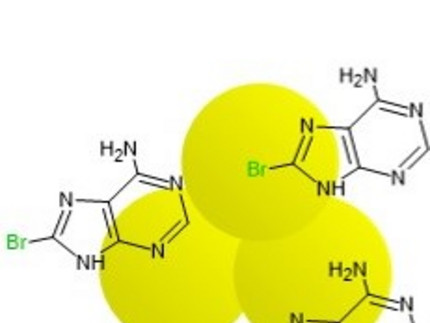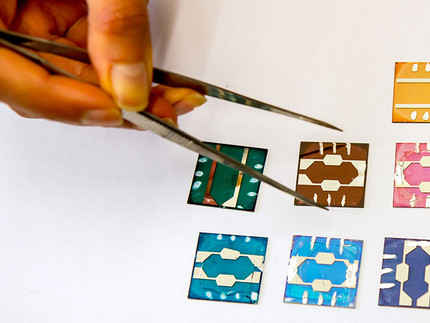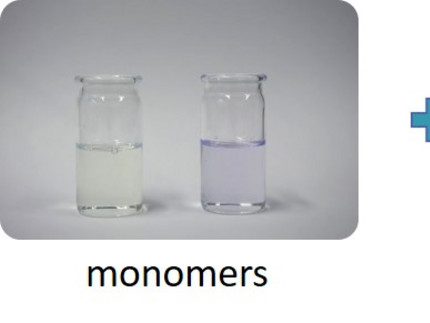Influence of nanoparticle size on plasmon-induced reactions
The research work of Christina Beresowski from the Colloid Chemistry group headed by Prof. Dr. Ilko Bald deals with plasmon-induced reactions caused by the excitation of nanoparticles and the associated generation of so-called "hot electrons". In particular, the size effect of the plasmonic nanoparticles on the reaction kinetics is investigated. For this purpose, the molecules to be studied must adsorb on the surface of the nanoparticles. In the next step, the functionalized nanoparticles are dropped onto a silicon wafer, where they aggregate after subsequent drying. Surface-enhanced Raman spectroscopy (SERS) is used to induce and simultaneously follow the reaction.
Download Transfer Offer 23-04 (PDF, 606 KB)
Antimicrobial Bottle Brush Copolymers
The development of antibiotic resistance in bacteria is a growing problem in our society, making the development of effective alternatives increasingly important. One possible solution are antimicrobial polymers. The main focus of our research is the synthesis and analysis of antimicrobial bottle brush copolymers. It has been shown that bottle brush copolymers have higher antimicrobial activities and lower toxicity towards red blood cells compared to linear chains, resulting in improved biocompatibility. Antimicrobial copolymers are not only effective against normal bacteria, but can also prevent growing of antibiotic-resistant bacteria. In order to access complex macromolecular architectures even faster and easier, new polymerization techniques based on photoiniferter RAFT polymerization are being developed in our group (Polymer Biomaterials Group of Dr. Matthias Hartlieb).
Download Transfer Offer 23-03 (PDF, 681 KB)
Optical Fiber Sensors
The FöWiTec-funded project of the Functional Materials group of Dr. Claudia Pacholski deals with the fabrication of tailored optical fiber sensors and investigates both their chemical and optical properties. The work focuses on equipping the fiber tips with nanomaterials, such as porous silicon and stimuli-responsive polymers. The porous silicon is generated by electrochemical or metal-assisted etching, and both the pore size and the optical response of the material are freely adjustable. By combining the porous material with polymers, optical fiber sensors can be produced to precisely fit a targeted application.
Download Transfer Offer 23-01 (PDF, 624 KB)
Disordered semiconductors
Prof. Dr. Safa Shoaee's ‘Disordered Semiconductor Optoelectronics’ research group is interested in understanding and developing cost-effective, large-area, and environmentally friendly photovoltaic technologies. The team is therefore investigating disordered carbon-based semiconductors, particularly organic semiconductors, to find out how these materials function electrically and optically and which of their properties influence how efficiently they convert light energy into electrical energy.
Download Transfer Offer 22-06 (PDF, 638 KB)
Modifications of coffee grounds as an adsorbent for water filtration
Water is becoming a very valuable resource. Economically viable and efficient methods of producing clean water for the world's growing population are therefore becoming increasingly important. One possible treatment for pure water production is the removal of pollutants by adsorption. Although quite expensive, activated carbon (AC) is often used for this purpose. Coffee grounds (SC), on the other hand, are an abundant and cheap raw material that is disposed of daily in large quantities worldwide and is already known for the removal of, e.g., heavy metals, colourants, or organic acids [1-3].
Download Transfer Angebot 22-05 (PDF, 637 KB)
Crystallization & X-Ray Structure Analysis
Dr. Eric Sperlichheads the X-ray crystallography service group at the Institute of Chemistry at the University of Potsdam. Together with his team, he undertakes the crystallization of substances, the structural analysis of single crystals using X-ray crystallography and the subsequent evaluation. Together with researchers, he has already published more than 50 new crystal structures.
The support service is available to both internal and external scientists as well as business partners.
Download Transfer Offer 22-04 (PDF, 524 KB)
Surface Sensitive Filtration of Microparticles
Under the project management of Dr. Marek Bekir, a new technology for chromatography is being developed that is suitable for particles in the micrometer range. A light-responsible surfactant is used for this process. Depending on the material and surface morphology (roughness, porosity) of the particles, different amounts of surfactant are absorbed.
Download Transfer Offer 22-03 (PDF, 152 KB)
Ionic liquids based materials as electrolytes in fuel cells
Alyna Lange’s research in the group of Prof. Andreas Taubert is mainly based on the synthesis, properties and use of ionic liquids (ILs) and their derivatives for the application as electrolytes. ILs are salts which, like our table salt, consist mostly of ions. In contrast to common salts, ILs have a melting point below 100 °C, some are even liquid at room temperature. Moreover these substances have a negligible vapor pressure, are not flammable and show high thermal and electrochemical stability as well as ionic conductivities. These properties make ILs promising candidates as alternative electrolytes for solar cells, batteries or fuel cells.
Download Transfer Offer 22-01 (PDF, 536 KB)
Applied Optical Sensors and Spectroscopy
The Applied Optical Sensing and Spectroscopy group, headed by apl. Prof. Michael Kumke focuses its research on lanthanides, which are used as luminescent probes in the life and environmental sciences as well as in clinical diagnostics in downshifting and frequency upconversion applications. As the electromagnetic radiation required for excitation in the case of frequency upconversion is in the NIR range and there is only low absorption by water and other biological materials in this range, the potential for optical-based sensor technology in life and environmental science applications is very high. One focus is on the production of novel lanthanide-containing nanoparticles whose surface is modified with biomarkers. Other ongoing research projects include bio-inspired filter materials for lanthanide recovery, physicochemical processes in the near and far field of repositories, nanoparticles for SOEC/SOFC applications, and the remote detection of leaks in hydrogen pipelines.
Download Transfer Offer 21-10 (PDF, 671 KB)
Ultra sensitive and robust POCT approaches for diagnostics
Prof. Dr. Frank Bier’s research group of Molecular Bioanalytics and Bioelectronics focuses on medical diagnostics, especially the development of point-of-care testings (POCT), using different molecular biological and biochemical techniques. Currently, the work focuses on various assay developments for the detection of COVID-19. The main motivation is to design smart and innovative POCT suitable for at-home-testing. One of the research projects investigates the detection of viral RNA to enable an early and reliable diagnosis of infections with SARS-CoV-2 and other pathogens. For a simple and sensitive detection a test strip assay format is combined with the much noticed technique of Loop-Mediated Isothermal Amplification (LAMP) of nucleic acids. For the application oriented research projects, the group collaborates with numerous research institutions as well as companies and industries mainly in Brandenburg-Berlin area.
Download Transfer Offer 21-09 (PDF, 3,95 MB)
Sustainable and low cost water treatment materials
Adsorbents based on renewable raw and waste materials, e.g. from the food industry and agroindustry, are produced via a variety of chemical modifications, thermal treatment, and addition of further functional components, such as abundant minerals like clay. The resulting materials act as adsorbents that can be used for the removal of heavy metals, organic pollutants, pharmaceuticals, pesticides, herbicides, and biological contamination.
Download Tansfer Offer 21-08 (PDF, 508 KB)
Superstructures with nanoparticles of defined shape and size
The research group of Prof. Joachim Koetz is dealing with the synthesis of nanoparticles of different shape and size and their application as sensor materials and for the surface- enhanced Raman spectroscopy for the detection of molecules and reaction mechanisms. The important thing here is the separation and isolation of anisotropic nanoparticles (nanotriangles and nanostars) and their surface modification. In addition to the self- organization of gold and magnetite nanoparticles, the research is focused on the insertion of these particles into Janus emulsions. This makes it possible to adjust the droplet size of stimuli-sensitive Janus emulsions, and respectively the pore sizes of the resulting aerogels. The ultralight magnetic aerogels can be used for purifying liquids (dye and oil layer separation).
Download Transfer Offer 21-02 (PDF, 15,3 MB)
Polymeric Biomaterials
Antimicrobial resistance (AMR) is one of the most serious issues of today’s public health. This is where the DFG - Emmy Noether research group Polymere Biomaterialien, led by Dr. Matthias Hartlieb, starts searching for possible solutions. The scientists aim to develop membrane active, antimicrobial polymers, which are so selective towards pathogenic bacteria that they compete with conventional antibiotics. Surface coatings (on medical devices or implants) will also be investigated in the future. The advantage of such materials: the development of resistance is almost impossible.
Download Transfer Offer 20-10 (PDF, 616 KB)
Cellulose derived novel bioplastic
This bioplastic is the first polymerization of levoglucosenyl methyl ether (LME), derived from sustainable feedstock (cellulose), and developed in the research group of Prof. Helmut Schlaad.
Download Transfer Offer 20-01 (PDF, 652 KB)














